
The headrest in your car may be one of its most overlooked safety features. As long as you’re comfortable while driving, you probably don’t pay it much attention. When it comes to overall vehicle safety, your seatbelt and airbags are probably the first things that come to mind. But your headrest—also known as a “head restraint”—is equally important. Here are some useful facts you might not know for proper car headrest safety!
What is the Proper Height for Your Car Headrest?
You probably only adjust your headrest for comfort, but did you know its height can also impact its effectiveness? Here’s how to make sure it’s properly positioned:
- Try to keep the top of your headrest level with the top of your head
- Keep the middle of the headrest level with your ears—and make sure it’s not positioned lower than your ears!
- Minimize the distance between the back of your neck and your headrest (aim for 3–4 inches).
Keep these tips in mind as you travel with different passengers and help them make sure the headrest is properly adjusted for their height.
How Well Do Headrests Prevent Whiplash?
Headrests are designed to prevent neck injuries in rear-end collisions by keeping your head and neck aligned with your torso as your body moves forward.
Whiplash injuries occur with a sudden movement of the head, often a quick back-and-forth motion. In the event of a rear-end crash, your head will swing forward and then backwards. If your headrest is too low, your head won’t be properly protected.
While your headrest alone isn’t guaranteed to totally prevent an injury, it is designed to work with your vehicle’s other safety features to be as effective as possible. Tested by organizations like the Insurance Institute for Highway Safety (IIHS) and the National Highway Traffic Safety Administration (NHTSA), your car headrest is an important defense against head and neck injuries.
Is It Illegal to Remove Your Car Headrests?
You may be tempted to remove your headrests if they seem too large to safely check your blind spot while driving. You may also want to remove them for a different style, or even temporarily when you’re moving large items in your vehicle.
Whether or not it’s illegal to remove your headrests will depend on where you live and the model of car you drive. For example, in some states, newer cars may have more specific regulations than older models. In the U.S., car headrests weren’t a mandatory safety feature until the 1960s.
If you plan to buy a new headrest, especially an easily removable headrest, you should make sure that it meets the proper safety standards. If you’re unsure, speak with your local police department! It’s better to ask than to learn the answer after getting pulled over.
Do You Know What’s Included in Your Vehicle Inspection?
- Why You Should Always Park Between the Lines - March 7, 2019
- 10 Car Organization Hacks - March 7, 2019
- What to Expect While Business 40 is Closed for Construction - March 5, 2019
Write a comment:
You must be logged in to post a comment.








